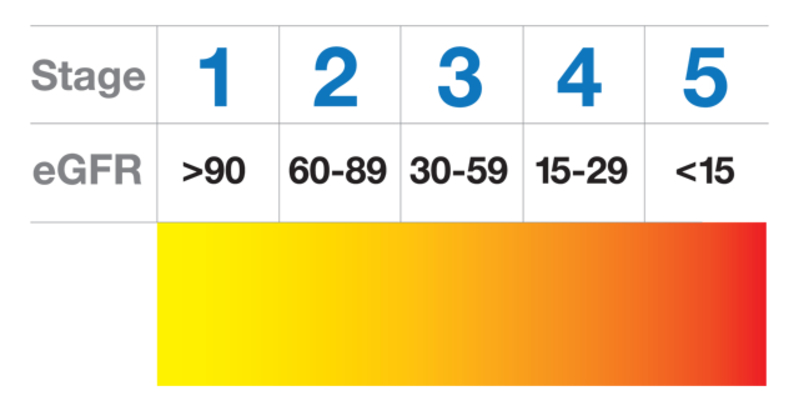Measuring Kidney Function
Kidneys that don’t work well don’t remove as many wastes from your blood. These wastes can be measured in your blood. The results can tell your care team if you have a problem even before you have any symptoms. Your doctor will check the creatinine level in your blood as one way to see how well your kidneys are working. Your creatinine can then be used to find out your eGFR (estimated glomerular filtration rate)—or your percent (%) kidney function.
Removing Creatinine from Your Blood
Healthy kidneys remove creatinine from the blood at the same rate that your body makes it. So, if a blood test for creatinine shows higher than normal levels, it could mean that you have a kidney problem—even if you feel fine. Your creatinine level is used to estimate your eGFR. The good news is, there is a lot you can do to slow a kidney problem. To learn how to take action, read about How to Protect Your Kidneys.
Stages of Chronic Kidney Disease
Your eGFR is a measure of how well your kidneys are working. It is estimated based on your creatinine level, age, race, and whether you are a man or a woman.
Chronic kidney disease, or CKD, has five stages that are based on eGFR. Healthy people have an eGFR of 90 or higher. Most people don’t find out that they have CKD until they reach stage 3 or 4—or even 5. Kidney failure means that the eGFR is 15 or less. This is also called “end-stage renal disease,” or ESRD. To learn about treatment options for kidney failure, visit the Treatment Room.
Calculate Your eGFR
If you know your creatinine level, you can use this eGFR Calculator to get your estimated eGFR.
What Does eGFR Mean?
CKD Stages 1–2: Kidney function is normal or near normal. (Urine tests are also needed to be sure this result is right.) If you believe you have symptoms of kidney disease, talk to your care team. Many health problems can cause the same sorts of symptoms. Do you have a family history of kidney disease or risk factors like high blood pressure or diabetes? If so, take steps to protect your kidneys—like getting screened once a year with blood and urine tests.
CKD Stage 3: This means moderate kidney damage that may be slowed or stopped with treatment and lifestyle changes. At stage 3 CKD, you have a good chance of never reaching kidney failure if you TAKE ACTION. To learn more about what YOU can do, read How to Protect Your Kidneys. You may have some symptoms of kidney disease at this stage. If you do, talk to your care team.
CKD Stage 4: This means severe kidney damage that may be slowed with treatment and lifestyle changes. There is still time to protect the kidney function you have left. You may have some symptoms of kidney disease. If you do, talk to your care team. To learn more, visit the Symptoms of Kidney Disease topic. If you have not picked a treatment, it’s wise to pick one as soon as you can. To learn about your treatment options, visit the Treatment Room.
CKD Stage 5: This is “end-stage renal disease” (ESRD) and means treatment will soon be needed for kidney failure. Some symptoms of kidney disease may be present. If so, talk to your care team.
Low eGFR + Protein in Your Urine = Trouble
One way to find kidney disease is through an eGFR test. But, there is another way. If you have protein in your urine, this can be a sign of kidney damage. To learn more about protein in the urine, visit the Measuring Albumin Topic.
This chart shows how eGFR and protein in the urine add up to kidney trouble. (Click on the chart to make it larger.) If you have either of these problems, your care team can help you. Early treatment can slow kidney problems down so you can feel your best.
What You Can Do About eGFR
There is a LOT you can do to help slow the rate of your kidney disease. Healthy food choices, exercise, keeping your blood sugar and blood pressure in control, and quitting smoking are some ways that can help. Learning to manage chronic kidney disease can be a little like a part-time job. To learn more, visit the How to Protect Your Kidneys topic.

You've reached the end of this topic:
Creatinine & eGFR
- Kidney disease can be silent until:
Not scored You may not be able to feel early kidney damage. The symptoms of kidney disease can be very subtle.
- Creatinine is:
Not scored Your care team measures creatinine in your blood to see how well your kidneys remove it.
- If a blood test for creatinine shows a higher than normal level, it could mean:
Not scored Healthy kidneys remove creatinine from your blood. If your levels are high, you may have a kidney problem.
- Your eGFR is about the same as:
Not scored If your eGFR is 59, this means that you have about 59% of normal kidney function.
- There is a lot you can do to slow kidney disease:
Not scored The steps you can take to slow kidney disease can help keep your whole body healthy. These include things like keeping your blood sugar and pressure in control, not smoking, and eating a healthy diet.































